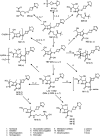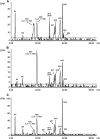Absorption, Metabolism, and Excretion of [14C]-Tebipenem Pivoxil Hydrobromide (TBP-PI-HBr) in Healthy Male Subjects
- PMID: 36995239
- PMCID: PMC10112213
- DOI: 10.1128/aac.01509-22
Absorption, Metabolism, and Excretion of [14C]-Tebipenem Pivoxil Hydrobromide (TBP-PI-HBr) in Healthy Male Subjects
Abstract
Tebipenem pivoxil hydrobromide (TBP-PI-HBr) is an oral prodrug of pharmacologically active moiety tebipenem (TBP), which is a carbapenem with activity against multidrug-resistant Gram-negative pathogens. Conversion from the prodrug to the active moiety, namely, TBP, occurs in the enterocytes of the gastrointestinal tract via intestinal esterases. The absorption, metabolism, and excretion in humans were evaluated, following the administration of a single oral dose of [14C]-TBP-PI-HBr. Healthy male subjects (n = 8) received a single 600 mg oral dose of TBP-PI-HBr containing approximately 150 μCi of [14C]-TBP-PI-HBr. Blood, urine, and fecal samples were collected to determine the total radioactivity, concentrations of TBP (plasma only), and metabolite profiling and identification. The overall mean recovery of the total radioactivity in urine (38.7%) and feces (44.6%) combined was approximately 83.3% of the administered dose, with individual recoveries ranging from 80.1% to 85.0%. Plasma TBP LC-MS/MS and metabolite profiling data suggest that TBP was the main circulating component in plasma and that it accounts for approximately 54% of the total plasma radioactivity, based on the plasma AUC ratio of TBP/total radioactivity. The ring-open metabolite LJC 11562 was another major component in plasma (>10%). TBP (M12), LJC 11562, and four trace to minor metabolites were identified/characterized in the urine. TBP-PI, TBP (M12), and 11 trace to minor metabolites were identified/characterized in the feces. The renal and fecal routes are major clearance pathways in the elimination of [14C]-TBP-PI-HBr, with a mean combined recovery of 83.3%. TBP and its inactive ring-open metabolite LJC 11562 were the major circulating metabolites in the plasma.
Keywords: absorption; excretion; mass balance; metabolism; tebipenem.
Conflict of interest statement
The authors declare a conflict of interest. G.M. and L.G. are consultants to Spero Therapeutics, Inc. All other authors were paid employees of Spero Therapeutics, Cambridge, MA at the time of this study.
Figures






Similar articles
-
Effect of an Antacid (Aluminum Hydroxide/Magnesium Hydroxide/Simethicone) or a Proton Pump Inhibitor (Omeprazole) on the Pharmacokinetics of Tebipenem Pivoxil Hydrobromide (TBP-PI-HBr) in Healthy Adult Subjects.Antimicrob Agents Chemother. 2023 Apr 18;67(4):e0149522. doi: 10.1128/aac.01495-22. Epub 2023 Mar 21. Antimicrob Agents Chemother. 2023. PMID: 36943038 Free PMC article. Clinical Trial.
-
Pharmacokinetics of Oral Tebipenem Pivoxil Hydrobromide in Subjects with Various Degrees of Renal Impairment.Antimicrob Agents Chemother. 2022 May 17;66(5):e0240721. doi: 10.1128/aac.02407-21. Epub 2022 Apr 14. Antimicrob Agents Chemother. 2022. PMID: 35420493 Free PMC article.
-
Randomized, Double-Blind, Placebo- and Positive-Controlled Crossover Study of the Effects of Tebipenem Pivoxil Hydrobromide on QT/QTc Intervals in Healthy Subjects.Antimicrob Agents Chemother. 2021 Jun 17;65(7):e0014521. doi: 10.1128/AAC.00145-21. Epub 2021 Jun 17. Antimicrob Agents Chemother. 2021. PMID: 33875429 Free PMC article. Clinical Trial.
-
Bioequivalence of two oral formulations of tebipenem pivoxil hydrobromide in healthy subjects.Clin Transl Sci. 2022 Jul;15(7):1654-1663. doi: 10.1111/cts.13280. Epub 2022 Apr 28. Clin Transl Sci. 2022. PMID: 35411579 Free PMC article. Clinical Trial.
-
Tebipenem pivoxil hydrobromide-No PICC, no problem!Pharmacotherapy. 2021 Sep;41(9):748-761. doi: 10.1002/phar.2614. Epub 2021 Aug 17. Pharmacotherapy. 2021. PMID: 34370326 Review.
Cited by
-
Impact of tebipenem pivoxil on the intestinal microbiota and on establishment of colonization with carbapenem-resistant Klebsiella pneumoniae in mice.Microbiol Spectr. 2025 Mar 14;13(5):e0234624. doi: 10.1128/spectrum.02346-24. Online ahead of print. Microbiol Spectr. 2025. PMID: 40084911 Free PMC article.
References
-
- Citron DM, Tyrrell KL, Rubio A, Goldstein EJC. 2018. In vitro activity of tebipenem (SPR859), tebipenem-pivoxil (SPR994) and meropenem against a broad spectrum of anaerobic bacteria. SUN-559. ASM Microbe.
-
- Mendes RE, Rhomberg PR, Watters A, Cotroneo N, Rubio A, Flamm RK. 2018. Antimicrobial activity assessment of tebipenem (SPR859) against an isolate collection causing urinary tract infections. ASM Microbe.
Publication types
MeSH terms
Substances
LinkOut - more resources
Full Text Sources
Research Materials
Miscellaneous

